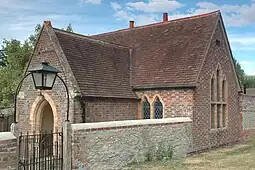Cuxham
Cuxham is a village and former civil parish, now in the parish of Cuxham with Easington, in the South Oxfordshire district, in the county of Oxfordshire, England. It is about 5.5 miles (9 km) north of Wallingford and about 6 miles (10 km) south of Thame. In 1931 the parish had a population of 129.[1] On 1 April 1932 the parish was abolished and merged with Easington to form "Cuxham with Easington".[2]
| Cuxham | |
|---|---|
 Holy Rood parish church | |
 Cuxham Location within Oxfordshire | |
| OS grid reference | SU6695 |
| Civil parish | |
| District | |
| Shire county | |
| Region | |
| Country | England |
| Sovereign state | United Kingdom |
| Post town | Watlington |
| Postcode district | OX49 |
| Dialling code | 01491 |
| Police | Thames Valley |
| Fire | Oxfordshire |
| Ambulance | South Central |
| UK Parliament | |
Parish church
The Church of England parish church of the Holy Rood has a Norman bell tower.[3] The Gothic windows on the north side of the nave were inserted in the 14th century and some of the windows in the tower were added in the 15th century.[4] The windows on the south side of the nave were probably inserted in the 17th century and the church was heavily restored in the 18th century.[4] The Gothic Revival architect C.C. Rolfe rebuilt the chancel in 1895.[4] The Rectory is Georgian and was built about 1800.[4] Since 1983 Holy Rood has been part of a united benefice with Easington, Brightwell Baldwin and Ewelme.[5]
Mills
The Domesday Book of 1086 recorded three watermills at Cuxham.[6] The present Cuxham Mill was built in about the middle of the 18th century on the site of one of those recorded in the Domesday Book.[6] It was held by the Benedictine Wallingford Priory before Merton College, Oxford acquired the Manor of Cuxham in about 1268–71.[6] In the Middle Ages, Cutt Mill was the manorial corn mill.[7] The present mill on the site was built in the middle of the 18th century.[7]
Amenities
The Half Moon public house was built in the 17th century and extended in the 18th.[8] It is built of chalk rubble with brick quoins.[8] Recently modernised, it is now a pizzeria and gastropub.[9]

References
- "Population statistics Cuxham AP/CP through time". A Vision of Britain through Time. Retrieved 19 August 2023.
- "Relationships and changes Cuxham AP/CP through time". A Vision of Britain through Time. Retrieved 19 August 2023.
- Sherwood & Pevsner 1974, p. 567.
- Sherwood & Pevsner 1974, p. 568.
- Brightwell Baldwin: church
- Historic England. "Cuxham Mill (1182026)". National Heritage List for England. Retrieved 20 January 2012.
- Historic England. "Cutt Mill (1059752)". National Heritage List for England. Retrieved 20 January 2012.
- Historic England. "The Half Moon Public House (1059746)". National Heritage List for England. Retrieved 20 January 2012.
- The Half Moon at Cuxham
Sources
- Harvey, P.D.A. (1965). An Oxfordshire Village: Cuxham 1240 to 1400. Oxford Historical Series. Oxford: Oxford University Press.
- Sherwood, Jennifer; Pevsner, Nikolaus (1974). Oxfordshire. The Buildings of England. Harmondsworth: Penguin Books. pp. 567–568. ISBN 978-0-14-071045-8.
External links
![]() Media related to Cuxham at Wikimedia Commons
Media related to Cuxham at Wikimedia Commons
